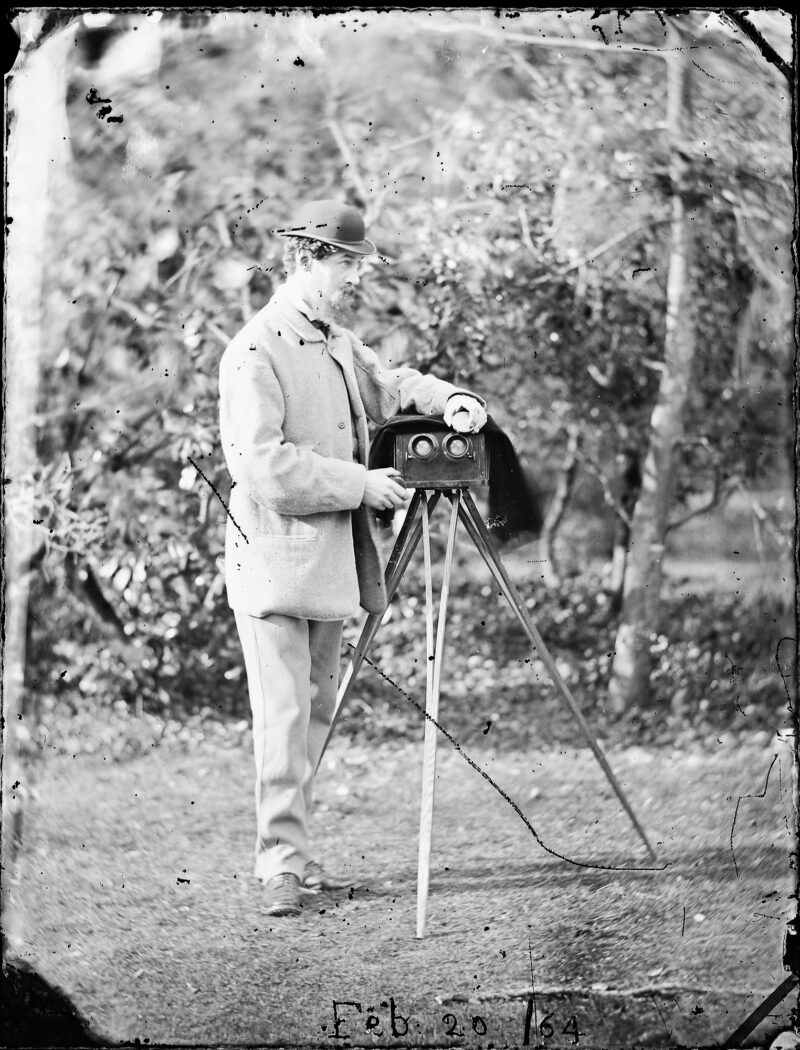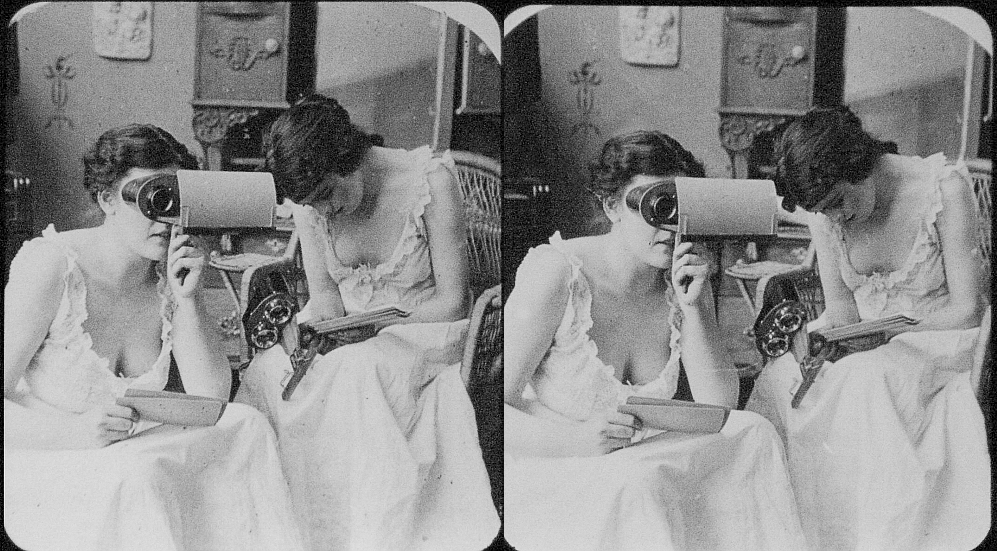
Lord Dunlo in garden with stereo camera by the Dillon Family, 1864
What is stereoscopy and how to view
- What is stereoscopy?
Stereoscopy is a technique used to create or enhance the illusion of three-dimensional depth in images or films. It relies on presenting two slightly offset images separately to each eye, mimicking the natural binocular vision humans have. When viewed together, the brain combines these images to perceive depth and form, creating a sense of immersion and realism. Stereoscopy is used in photography, filmmaking, and virtual reality to enhance the visual experience and create a more immersive environment for viewers.
- Why no VR?
While virtual reality (VR) offers an immersive experience, stereoscopy stands out for several reasons. Firstly, stereoscopy often boasts higher optical quality, providing sharper and more detailed images compared to digital simulations. Additionally, stereoscopy offers the unique advantage of archival physical prints on photographic paper, preserving memories in tangible form for generations to come.
Furthermore, stereoscopy allows for the utilization of traditional photographic elements such as depth of field and bokeh, adding a layer of artistic expression and depth to images that cannot be replicated in VR environments. Each stereographer brings their own unique visual language to their work, resulting in a diverse array of captivating images that reflect their individual perspectives and creativity.
Intentional Image Composition: While VR may offer interactivity, it sacrifices the photographer’s control over composition. With stereoscopy, every detail is intentionally crafted, every angle carefully considered, resulting in professional imagery with a fixed frame that resonates with depth and precision.
Tactile Experience: Viewing stereo photographs through physical devices like stereoscopes provides a tactile and tangible experience that cannot be replicated by VR technology alone. This hands-on approach can be more engaging and immersive for some users.
Authenticity: Stereo photography captures real-world scenes and objects in three dimensions, offering an authentic representation of physical spaces and environments. This authenticity can be particularly valuable in fields like architecture, art, and documentation, where accurate representation is crucial.
Craftsmanship: Stereo photography often involves manual processes such as capturing images with stereo cameras, developing film, and mounting stereo pairs. This craftsmanship adds a level of artistry and appreciation to the final product, distinguishing it from digitally rendered VR environments.
Historical Significance: Stereo photography has a rich history dating back to the 19th century, with an extensive archive of historical stereo images documenting various aspects of culture, society, and technology. This historical significance adds value to stereo photography as a medium for preserving and sharing visual heritage.
- What is a stereoscope?
A stereoscope is a device used to view stereo photographs, also known as stereographs or stereo cards, in three dimensions. It typically consists of a viewer with two eyepieces and a set of lenses or mirrors that present two offset images to each eye. These images, when viewed together through the stereoscope, create the illusion of depth and dimensionality.
Stereoscopes have been used since the 19th century and were popular during the Victorian era as a form of entertainment and education. They allowed viewers to experience scenes from around the world, historical events, and everyday life in three dimensions.
There are various types of stereoscopes, including handheld viewers, tabletop viewers, and larger models designed for public viewing. Some modern stereoscopes are even designed to work with smartphones, allowing users to view stereo images using their mobile devices and a compatible viewer attachment. - Can I view 3D without a stereoscope?
Yes, you can still view stereo photographs without a stereoscope, although the experience may be different.
Here are two methods:
- The parallel view
You need to relax your eyes, as if watching something far away. Then hold a stereo image pair in front of your eyes. Each of the images need to be seen with one eye. They will then merge into 3D.
Especially for short-sighted persons will like this technique when taking off their glasses.
- The cross eye view
This basically means squinting. The two pictures of your stereo pair need to be switched. You then need to focus with your right eye onto the image on the left and vice versa.
Please note that OCZKO STEREO publishes stereo pairs only in parallel mode.
While a stereoscope provides the most comfortable and immersive way to view stereo photographs, these alternative methods can still offer a glimpse into the fascinating world of stereoscopy.
Have a look at this Tutorial.
Here is another one. - The parallel view
- What is a 3D wiggle?
A 3D wigglegram, also known simply as a wigglegram or stereographic animation, is a type of animated image that creates a three-dimensional effect through a rapid back-and-forth motion.
The images are alternated quickly, creating the illusion of depth and dimensionality as the subject appears to move or “wiggle” back and forth.
Wigglegrams are often created by taking a sequence of photographs while slightly shifting the camera position between each shot. These images are then compiled into an animated GIF or video file, where the rapid alternation between frames creates the illusion of depth when viewed.
Wigglegrams are a popular and fun way to add a sense of depth to still images, and they are commonly shared on social media platforms and photography websites as a form of creative expression. - How can I share stereo images on social media?
Sharing stereo images on social media can be a bit trickier than sharing traditional 2D images, but it’s definitely possible. Here are some tips on how to do it effectively:
- Create a wiggle GIF: Create a GIF or video file of your stereo image, showcasing the alternating left and right views. There are various software programs and online tools available that can help you create these animated files.
- Use Stereo Photo Viewing Apps: Some social media platforms support stereo image viewing through specialized apps or plugins. For example, Facebook has 3D photo support, which allows users to upload images that can be viewed in 3D using the Facebook app or website.
- Provide Viewing Instructions: If you’re sharing stereo images in their original format, be sure to include instructions on how to view them properly. You can explain the free viewing or parallel viewing techniques, or recommend using a stereoscope or viewer device for the best experience.
- Use Dedicated Communities: Consider sharing your stereo images in dedicated online communities or forums focused on stereoscopy or 3D photography. These platforms often have built-in support for viewing stereo images and a community of users who appreciate the format.
By following these tips, you can effectively share your stereo images on social media and showcase the unique depth and dimensionality they offer.
External links
- Theory & HistorySome great articles published by Rebecca Sharpe:
